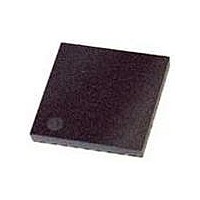ATTINY861-15MZ Atmel, ATTINY861-15MZ Datasheet - Page 136

ATTINY861-15MZ
Manufacturer Part Number
ATTINY861-15MZ
Description
MCU AVR 8K FLASH 15MHZ 32-QFN
Manufacturer
Atmel
Series
AVR® ATtinyr
Datasheet
1.ATTINY861-15MZ.pdf
(236 pages)
Specifications of ATTINY861-15MZ
Package / Case
32-VQFN Exposed Pad, 32-HVQFN, 32-SQFN, 32-DHVQFN
Voltage - Supply (vcc/vdd)
2.7 V ~ 5.5 V
Operating Temperature
-40°C ~ 125°C
Speed
16MHz
Number Of I /o
16
Eeprom Size
512 x 8
Core Processor
AVR
Program Memory Type
FLASH
Ram Size
512 x 8
Program Memory Size
8KB (8K x 8)
Data Converters
A/D 11x10b
Oscillator Type
Internal
Peripherals
Brown-out Detect/Reset, POR, PWM, WDT
Connectivity
USI
Core Size
8-Bit
Processor Series
ATTINY8x
Core
AVR8
Data Bus Width
8 bit
Data Ram Size
512 B
Interface Type
SPI
Maximum Clock Frequency
16 MHz
Number Of Programmable I/os
16
Number Of Timers
2
Maximum Operating Temperature
+ 85 C
Mounting Style
SMD/SMT
3rd Party Development Tools
EWAVR, EWAVR-BL
Development Tools By Supplier
ATAVRDRAGON, ATSTK500, ATSTK600, ATAVRISP2, ATAVRONEKIT, ATAVRMC320
Minimum Operating Temperature
- 40 C
On-chip Adc
10 bit, 11 Channel
Lead Free Status / RoHS Status
Lead free / RoHS Compliant
Available stocks
Company
Part Number
Manufacturer
Quantity
Price
Company:
Part Number:
ATTINY861-15MZ
Manufacturer:
ATMEL
Quantity:
1 465
- Current page: 136 of 236
- Download datasheet (2Mb)
136
ATtiny261/461/861
Table 17-1.
Note:
• Bit 3:2 – USICS1:0: Clock Source Select
These bits set the clock source for the USI Data Registerr and counter. The data output latch
ensures that the output is changed at the opposite edge of the sampling of the data input
(DI/SDA) when using external clock source (USCK/SCL). When software strobe or
Timer/Counter0 Compare Match clock option is selected, the output latch is transparent and
therefore the output is changed immediately. Clearing the USICS1:0 bits enables software
strobe option. When using this option, writing a one to the USICLK bit clocks both the USI Data
Register and the counter. For external clock source (USICS1 = 1), the USICLK bit is no longer
used as a strobe, but selects between external clocking and software clocking by the USITC
strobe bit.
Table 17-2 on page 137
clock source used for the USI Data Register and the 4-bit counter.
USIWM1
0
0
1
1
1. The DI and USCK pins are renamed to Serial Data (SDA) and Serial Clock (SCL) respectively
to avoid confusion between the modes of operation.
USIWM0
Relations between USIWM1..0 and the USI Operation
0
1
0
1
Description
Outputs, clock hold, and start detector disabled. Port pins operates as normal.
Three-wire mode. Uses DO, DI, and USCK pins.
The Data Output (DO) pin overrides the corresponding bit in the PORT Register
in this mode. However, the corresponding DDR bit still controls the data
direction. When the port pin is set as input the pins pull-up is controlled by the
PORT bit.
The Data Input (DI) and Serial Clock (USCK) pins do not affect the normal port
operation. When operating as master, clock pulses are software generated by
toggling the PORT Register, while the data direction is set to output. The USITC
bit in the USICR Register can be used for this purpose.
Two-wire mode. Uses SDA (DI) and SCL (USCK) pins
The Serial Data (SDA) and the Serial Clock (SCL) pins are bi-directional and
uses open-collector output drives. The output drivers are enabled by setting the
corresponding bit for SDA and SCL in the DDR Register.
When the output driver is enabled for the SDA pin, the output driver will force the
line SDA low if the output of the USI Data Register or the corresponding bit in
the PORT Register is zero. Otherwise the SDA line will not be driven (i.e., it is
released). When the SCL pin output driver is enabled the SCL line will be forced
low if the corresponding bit in the PORT Register is zero, or by the start
detector. Otherwise the SCL line will not be driven.
The SCL line is held low when a start detector detects a start condition and the
output is enabled. Clearing the Start Condition Flag (USISIF) releases the line.
The SDA and SCL pin inputs is not affected by enabling this mode. Pull-ups on
the SDA and SCL port pin are disabled in Two-wire mode.
Two-wire mode. Uses SDA and SCL pins.
Same operation as for the Two-wire mode described above, except that the SCL
line is also held low when a counter overflow occurs, and is held low until the
Counter Overflow Flag (USIOIF) is cleared.
shows the relationship between the USICS1..0 and USICLK setting and
(1)
.
2588B–AVR–11/06
Related parts for ATTINY861-15MZ
Image
Part Number
Description
Manufacturer
Datasheet
Request
R

Part Number:
Description:
Manufacturer:
Atmel Corporation
Datasheet:

Part Number:
Description:
Manufacturer:
Atmel Corporation
Datasheet:

Part Number:
Description:
IC MCU AVR 8K FLASH 20MHZ 32-QFN
Manufacturer:
Atmel
Datasheet:

Part Number:
Description:
IC MCU AVR 8K FLASH 20MHZ 20SOIC
Manufacturer:
Atmel
Datasheet:

Part Number:
Description:
MCU AVR 8K FLASH 15MHZ 20-SOIC
Manufacturer:
Atmel
Datasheet:

Part Number:
Description:
MCU AVR 8KB FLASH 15MHZ 32-VQFN
Manufacturer:
Atmel
Datasheet:

Part Number:
Description:
Microcontrollers (MCU) 8kB Flash 0.512kB EEPROM 16 I/O Pins
Manufacturer:
Atmel
Datasheet:

Part Number:
Description:
8-bit Microcontrollers - MCU 8KB FL 512B EE 512B SRAM 20MHZ IND 5V
Manufacturer:
Atmel

Part Number:
Description:
IC, MCU, 8BIT, 2K FLASH, 20SOIC
Manufacturer:
Atmel
Datasheet:

Part Number:
Description:
IC, MCU, 8BIT, 2K FLASH, 20PDIP
Manufacturer:
Atmel
Datasheet:













